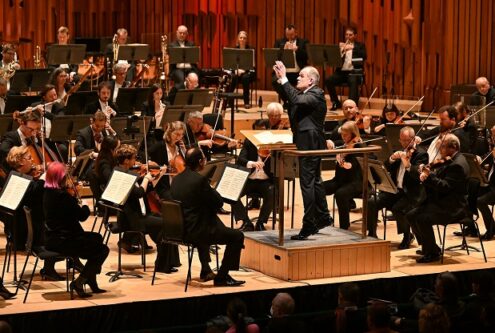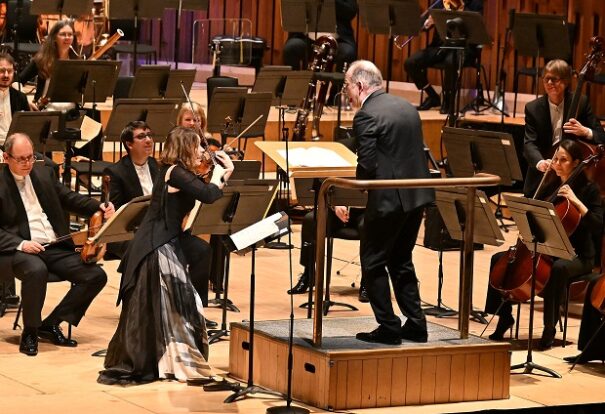 United Kingdom Ligeti and Beethoven: Patricia Kopatchinskaja (violin), London Symphony Orchestra, François-Xavier Roth (conductor). Barbican Hall, London, 16.2.2023. (MB)
United Kingdom Ligeti and Beethoven: Patricia Kopatchinskaja (violin), London Symphony Orchestra, François-Xavier Roth (conductor). Barbican Hall, London, 16.2.2023. (MB)

Ligeti (arr. Elgar Howarth) – Macabre Collage (UK premiere)
Ligeti – Violin Concerto
Beethoven – Symphony No.5 in C minor, Op.67
György Ligeti will turn 100 on 28 May. Let us hope for many performances as excellent as this in celebration of the most abidingly concert-hall-popular of post-war musical modernists. First, François-Xavier Roth conducted the London Symphony Orchestra in Elgar Howarth’s 2021 revision of his 1991 ‘collage’ from Le Grand Macabre. From the anarchic Monteverdi hommage of the opening, L’Orfeo’s Toccata revisited via twelve car-horns, to the closing passacaglia with swing, here to my ears slightly suggestive of Kurt Weill, Ligeti’s ‘anti-anti-opera’ or ‘comic apocalypse’ splendidly hit the absurdist spot of would-be annihilation in edited, wordless version. (If ever we needed a return to Breugelland, it is surely during our current NATO-Putin-Zelensky standoff.) Was that an allusion I heard early on to Beethoven’s Fifth Symphony? Perhaps, perhaps not. Does it matter? Again, one can argue either way. A musical melodrama of drumroll and offstage trombone set the, or at least a, drama proper in motion, Death drunkenly fiddling offstage, having us both fear and ridicule him, caught in the headlines of a Fate which Ligeti (and Beethoven) may or may not have summoned. The space was used resourcefully throughout, an E-flat clarinet peeking out from a hole in the wall that suggests, yet does not contain, an organ, various tricks beguiling and distracting as commedia dell’arte met something approaching music theatre. A tango-ish Rite, or just a rite? Hard-edged, metallic, it was splendidly theatrical, hallucinatory harpsichord, fairground Bach, and all: unsettling, even frightening fun at its best.

The Violin Concerto emerged in context as a microtonal dance of something between life and death, the first movement mesmerising in its difficulties and in Patricia Kopatchinskaja’s (and the LSO’s) despatch of them. A folklike, vibrato-less solo ‘Aria’ constantly surprised as other, hocketing instruments joined in deft evasion of the conventional, emotional or otherwise. Ocarinas versus virtuosic violin; piccolo, percussion, and horns: the ‘weird ironic homelessness’ (Seth Brodsky) of this movement held us in its thrall. Its successor, the ‘Intermezzo’ sounded as if an electronic Prokofiev reverie; it is none of those things really, of course, but perhaps the ‘real’ has been overrated. Another passacaglia, here of shifting stillness, ensued, lengthy violin harmonic notes eventually rudely assailed, so as to turn things loudly inwards — then outwards. Shaping from all concerned, Roth as much as the soloist, showed both careful precision and febrile abandon. The finale’s virtuoso fireworks emerged as strangely (in a good sense) hard won: a further mystery of the macabre. Kopatchinskaja’s own cadenza culminated in singing, whistling, stamping, and more — and not only from her. Leader Carmen Lauri joined her for an encore of the early (1950) violin duo Baladă şi joc, evoking more strongly than anything in the concerto a Bartókian, indeed Hungarian, past that soon would no longer be a desirable, or even conceivable, option for composition.
As agile in his podium pirouette from receipt of applause to commence Beethoven’s Fifth, applause still ongoing, as in his musical direction, Roth offered us a first movement unquestionably fast by historical standards, yet without being hard-driven. (For the nth time, speed and tempo are not the same thing.) Crucially, Beethoven’s score throughout pulsed with life: a banal cliché, no doubt, but sometimes words are truly insufficient. This was not, nor would anyone have expected it to be, a Beethoven in the line of Furtwängler, Klemperer, Barenboim, et al.; it was clearly influenced by Roth’s work with his period-instrument orchestra, Les Siècles, perhaps especially in the ripe, fruity presence of the LSO woodwind. (Just how did that metamorphosis take place?) But there was no dogmatism, simply a different, sincerely held, and powerfully communicated view. The astonishing textural clarity we heard was not an end in itself, but a means to hear, to feel, musical process. Just as the move to the relative major for the second group inevitably — and irrespective of ‘intention’ — sounded a moral as well as a ‘purely’ musical transformation, so did the necessity of further struggle in the recapitulation-as-second-development. The movement’s concision shocked and enthralled as it must, and if, at the close, I felt energy had triumphed over tragedy, or rather there had been a degree of dissociation, then not everything, even in Beethoven, is or need be Romanticism.
In the second movement, flowing freely, articulation enhanced rather than detracting from the longer line. The martial, French Revolutionary quality to brass interventions was rich in resonance (of various kinds). Every section of the LSO played superbly, but the gorgeous sound of the cellos perhaps merits special mention. Again, this was a vivid communication of form and melodic line as one: wholly involving, as was the implacable, subjectively aware Scherzo, whether first time around or in ghostly (here, perhaps ghostlier than I have ever heard) reprise. The sheer energy of contrapuntal outburst in the trio offered an excellent presentiment of the transition to the finale, which was yet not foreshadowed by that presentiment. Again, Roth’s way here was neither Wagnerian nor even especially post-Wagnerian, but that is not to say it lacked its own metaphysics or at least philosophy. At any rate, the sheer physical thrill of what unfolded had its own, perhaps more materialist tale to tell. Later transitions were just as seamless, which is of course not to say without import. This, then, was a reading of great cumulative power, to which the LSO appeared and sounded entirely committed throughout.
Mark Berry
